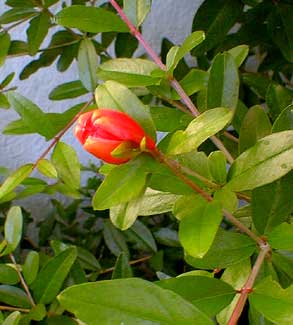
The Pomegranate of Ancient Myth
"A single fruit grew on that tree, a bright pomegranate fruit. Persephone stood up in the chariot and plucked the fruit from the tree. Then did Aidoneus prevail upon her to divide the fruit, and, having divided it, Persephone ate seven of the pomegranate seeds."
-The Golden Fleece
by Padraic Colum
(1881-1972)
by Padraic Colum
(1881-1972)
The genus name Punica is the name of the ancient city of Carthage. It has been cultivated since ancient times, & was once known as "the Carthage apple," apparently after ancient groves of pomegranates.
In the ancient & medieval worlds, pomegranates symbolized birth & death, being itself capable of bleeding. It was frequently associated with maidens & maiden-goddesses, for its bloodiness was often identified with the menses of an underworld goddess. It had simultaneous positive & negative associations, as cthonic divinities, & in particular Earthmothers, were the sources of Life & of Death, of Health & of Illness, of Fertility & Infertility.
It was the fruit of Kore the Maid, or Persephone, whom even as an underworld divinity was beautiful & kind. In Christian iconographic paintings, the Virgin Mary often holds Persephone's pomegranate, symbolizing Mary's authority over the death of her son, much as Athena in her dark or gorgon-like moods upheld a pomegranate in her left hand.
In ancient Syria the god Rimmon [2 Ki 5:18], whose name means "Pomegranate," was akin to Jesus & Tamuz & Baal Hadad, a sacrificial divinity who passes temporarily through death, & whose resurrection is either instigated by or attended exclusively by women, nymphs, or goddesses. Many biblical personages & locations were named for this very god, who seems to have continued to be worshipped in the lands aportioned to Simeon [Josh 15:32] & Zebulun [19:13]. Rimmon seems for a while to have been a national deity overseeing lamentations for the death of Israel's kings [Zech 12:11]. Rimmon had also a sacred site in Benjamin, where the name Rimmon was associated with the father of killers [2 Sm 2-9]. A Benjamanite sanctuary in time of warfare & extreme crisis was named for the Pomegranate Rimmon & for his consort Shala, whose name means "Bride" or "Rock" [Jg 20:45-47; 21:13].
Shala the Bride or Rock was possibly the same as the maidenly Side ("Pomegranate") who in Greek myth vied with Hera in a competition of beauty. She was a very ancient divinity of Boeatian origin. As the wife of Orion she was, like Orion, both a stellar & cthonic divinity, though dwindled in Greek myth to little more than a failed rival of Hera. For her audacity she was punished, being made to believe she had caused the death of her own children. In consequence she threw herself from a high cliff upon a rock. Where her blood spilled upon the rock, the first pomegranate tree arose. In another version, she was cast into Hades for pretending to the beauty of Hera, & lived as a gloomy nymph of an underworld pomegrante forest from which Persephone's only winter meal was plucked.
Side's association with the death of children is something that recurs in pomegranate lore of many nations. In Buddhist lore, the demoness Hariti was originally a child-eater like Lilith. The Buddha cured her of child-eating by teaching her to sublimate her forbidden desire by eating, instead, crunchy bloody pomegranates. She became thereafter a protectress of little children. In Japan, where she was called Kishimojin, she was called upon by infertile women to bring fertility to their wombs. She is depicted as suckling an infant & holding a pomegranate aloft.
Pomegranate as Forbidden Desire was also a component of its meaning within Athena's Parthenon, but the forbidden desire to eat of the fruit also underlays the Persephone myth & numerous Pomegranate legends.
To ancient Persians the pomegranate symbolized invincibility in battle, extending the fruit's authority over death. In India, Kali & Durga after devouring demons was said to have teeth like pomegranate flowers, which is to say, red with blood. But in her quiescent mood Mahadevi sat beneath a pomegranate tree distributing wealth to the world. Kali's son, elephant-headed Ganesha, or Ganapati, is frequently seen holding a pomegranate in one of his many hands or in his elephant trunk.
In Jewish lore it was again the fruit of things forbidden, growing upon the Tree of Knowledge (of sexuality & death) forbidden to Adam & Eve. For the mystic Moses Cordovero, pomegranates represented the divine emanations of God such as dwelt upon the Sephiroth Tree, with both dark & light aspects. In the Song of Songs Rabbah, we are told that the seeds of a pomegranate represent children studying Torah, which may bear some relationship to an idea from Islamic legend, that each seed of the pomegranate is capable of producing a different fruit from paradise.
Another Jewish legend associates the pomegranate with death & with the menstruant or polluted woman, a Lilith or a harlot. The Talmud tells us of a time when the wife of Rabbi Hiyya ben-Abba disguised herself as Harutha the Forbidden Maiden to test her husband's will-power. When he saw the gorgeously bedecked demoness, he became most excited, & cried out, "Who are you?" She replied, "I am Harutha. If you desire me, you may have me for the price of a pomegranate. Fetch me the one at the highest bough of that tree." Rabbi Hiyya hurried to climb the tree & obtained the pomegranate, but upon his return, he found only his wife, who reassured him, "You were only tempted by me." But her husband felt so guilty, he said, "Nevertheless, I would have done evil," & he fasted unto death.
See also the article about our garden's
Dwarf Pomegranate Shrubs